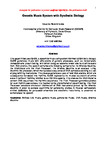Genetic Music System with Synthetic Biology
| dc.contributor.author | Miranda, Eduardo | |
| dc.date.accessioned | 2020-07-09T15:51:18Z | |
| dc.date.issued | 2020-08-10 | |
| dc.identifier.issn | 1064-5462 | |
| dc.identifier.issn | 1530-9185 | |
| dc.identifier.uri | http://hdl.handle.net/10026.1/15957 | |
| dc.description.abstract |
This paper introduces GeMS, a system for music composition informed by Synthetic Biology. GeMS generates music with simulations of genetic processes, such as transcription, translation and protein folding, with which biological systems render chains of amino acids from DNA strands. The system comprises the following components: the Miranda Machine, the Rhythmator and the Pitch Processor. The Miranda Machine is an abstract Turing Machine-like processor, which manipulates a sequence of DNA symbols according to a set of programming instructions. This process generates a pool of new DNA strands, which are subsequently translated into rhythms. GeMS represents the musical equivalent of amino acids in terms of rhythms, referred to as rhythmic codons. This enables the Rhythmator to convert DNA sequences into rhythmic sequences. The Pitch Processor generates pitches for such rhythmic sequences. It is inspired by the phenomenon of protein folding. The Pitch Processor considers orientation information of DNA instructions yielded by the Miranda Machine in order to activate algorithms for generating pitches. A musical composition, entitled Artibiotics, for percussion ensemble and electronic instruments, is presented to demonstrate the system. | |
| dc.format.extent | 1-27 | |
| dc.format.medium | Print-Electronic | |
| dc.language | English | |
| dc.language.iso | English | |
| dc.publisher | Massachusetts Institute of Technology Press (MIT Press) | |
| dc.subject | Artificial Life | |
| dc.subject | generative music | |
| dc.subject | Miranda machine | |
| dc.subject | DNA music | |
| dc.subject | genetic music | |
| dc.title | Genetic Music System with Synthetic Biology | |
| dc.type | journal-article | |
| dc.type | Journal Article | |
| plymouth.author-url | https://www.ncbi.nlm.nih.gov/pubmed/32772858 | |
| plymouth.issue | 3 | |
| plymouth.volume | 26 | |
| plymouth.publication-status | Published | |
| plymouth.journal | Artificial Life | |
| dc.identifier.doi | 10.1162/artl_a_00325 | |
| plymouth.organisational-group | /Plymouth | |
| plymouth.organisational-group | /Plymouth/Faculty of Arts, Humanities and Business | |
| plymouth.organisational-group | /Plymouth/Faculty of Arts, Humanities and Business/School of Society and Culture | |
| plymouth.organisational-group | /Plymouth/REF 2021 Researchers by UoA | |
| plymouth.organisational-group | /Plymouth/REF 2021 Researchers by UoA/UoA33 Music, Drama, Dance, Performing Arts, Film and Screen Studies | |
| plymouth.organisational-group | /Plymouth/Users by role | |
| plymouth.organisational-group | /Plymouth/Users by role/Academics | |
| dc.publisher.place | United States | |
| dcterms.dateAccepted | 2020-06-12 | |
| dc.rights.embargodate | 2020-9-5 | |
| dc.identifier.eissn | 1530-9185 | |
| dc.rights.embargoperiod | Not known | |
| rioxxterms.version | Accepted Manuscript | |
| rioxxterms.versionofrecord | 10.1162/artl_a_00325 | |
| rioxxterms.licenseref.uri | http://www.rioxx.net/licenses/all-rights-reserved | |
| rioxxterms.licenseref.startdate | 2020-08-10 | |
| rioxxterms.type | Journal Article/Review |


